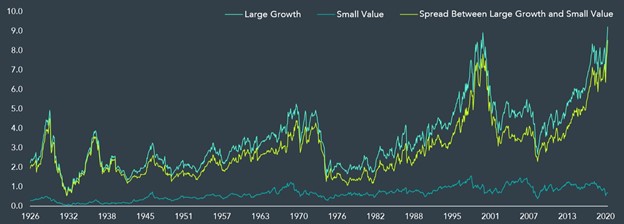As we’ve covered before, current stock prices are a reflection of all available public information and investor expectations. Anytime I buy a stock, someone else is on the other side of that transaction selling that stock. We have access to all of the same information, but it’s likely that we’ve come to different expectations about the future prospects for that stock. As the buyer, I see good prospects for that stock’s growth and as the seller the other person has decided that the prospects aren’t as good as an opportunity elsewhere. One of us will be right and one of us will be wrong, but the price at which we transact is a fair measurement of our combined expectations.
This is a simple example, but the same principles carry over to the real world. In fact, in the simple example above I assume that me and my counterpart are rational actors that have studied the stock we’re trading and have come to reasonable conclusions about its future prospects. I guarantee you that if I pick two market participants at random, it is very unlikely that they are both rational actors. The field of behavioral finance has a lot to say about that. Fortunately, rationality isn’t a prerequisite to effective markets. The principle that collective expectations are baked into current prices doesn’t rely on those expectations being rational—that is one of the reasons that it has proven so challenging to forecast short-term movements!
There are millions of market participants (some human and some algorithms created by humans) that are constantly trading stocks. That volume gives us an accurate representation of the collective expectations of all investors, and we can use that information.
By using valuation measures, we can begin to have a sense of where investor expectations lie. Price-to-earnings (P/E) is commonly cited as is price-to-book (P/B). There are many relative measures of valuation, but they all seek the same thing: to scale stock prices across a spectrum such that you can see which may have high expectations and which may not. Price-to-book is the measure I am using in the chart below and is simply the market capitalization (stock price × number of outstanding shares) of a company divided by its book value (assets minus liabilities). A higher valuation indicates investors are willing to pay a relatively high price for a company’s intrinsic value.

The top line shows valuations for Large Growth companies and the bottom line shows valuations for Small Value companies. The yellow line is the spread between the two. Large growth valuations are as high as they have ever been and not without reason! There may be perceived safety in some large stocks (Amazon, Apple, Facebook, Google, etc.) so investors are willing to pay for that. Investors may also have collective high hopes for the growth of those companies in the future. In the case of today’s large tech companies and the pandemic we are dealing with, those seem like reasonable assumptions to me. This is where the burden of those high expectations comes in.
How Expectations Influence the Future
Let me pause for a quick aside because there is another concept important to our understanding. Stock prices move because of changing information or changing expectations. If you follow markets closely, you see headlines like “Company X’s Q3 Earnings Beat Analyst Expectations” or “ABC Company Q4 Financials Fall Short of Expectations.” If future expectations are built into current prices then the reality of exceeding or falling short of those expectations will adjust the price up or down, respectively. It says nothing of what those expectations were—they could have been high or low—but the price moves solely because the company either beat them or came up short.
For those that may need another analogy here, think of it like the following equation that I’ve always used with my family:
Happiness = Reality – Expectations
In theory, I could provide a better reality for them, but isn’t it easier if I just tell them to lower their expectations? I joke, of course (sorry to my family who likely isn’t reading this anyway), but it’s the same concept as stock prices.
Stock Price Changes = Reality – Expectations
What It Means for Today
So we know both that expectations are historically high for large growth companies and that they need to exceed those expectations to have growth in their stock price. Essentially, investors have created a very high bar for future stock price increases. That does not mean they can’t exceed them! Expectations have been very high for those companies for the past several years and they have continued to outperform. It does, however, mean it’s getting harder to do so.
On the flip side, you have some Small Value companies with relatively low expectations. I don’t think that’s unreasonable in today’s environment. However, it does create a low bar.
The Large Growth companies have to continue to hit it out of the park to continue to see large gains in their stock prices. And they might! The Small Value companies may simply have to continue to exist to see large gains in their stock prices. And they may not! But if I’m looking for where the opportunities are over the next five-to-ten years, the odds are in our favor to hold more of the stocks with relatively low expectations.
Recent News
As an extremely short-term example, let’s look at the beginning of this week when Pfizer announced very positive results from their vaccine trials. Yes, it’s just a company press release about a small sample size, but the excitement seems to stem from the fact that their underlying method is being used by many other vaccines in development. Essentially, the odds of a vaccine sooner rather than later went up quite a bit.
In the two days following the announcement (and when I’m writing this), the S&P 500 (currently dominated by Large Growth companies) was relatively flat. Small Value companies, on the other hand, were up over 10%–a huge spread over two days. A bit of good news can go a long way when expectations are very low, and this was seemingly very good news. For the Large Growth companies, the good news simply fit in with the high expectations already priced in.
A Good Company Does Not Necessarily Mean it’s a Good Stock
There is a reason that expectations are high for some companies and low for others. The rapid change in stock prices over the last few days doesn’t mean the airlines, as one example, are in better shape as companies than Apple, Google, or Netflix. Being a poorly run company or one that is facing external challenges, however, does not guarantee that it will have poor stock performance. That is the advantage of low expectations. Just as true is that being a better company does not guarantee good stock performance. That is the burden of high expectations.


